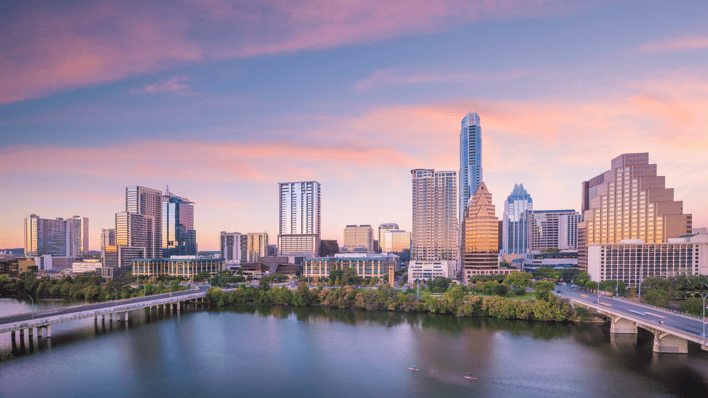Austin Housing Market in 2025: A City Set to Reignite With Growth
 Author: Michael Bernstein
Author: Michael BernsteinPublished:
From the outside, it might seem like the Austin housing market has been through a bit of a rollercoaster. And that’s not wrong—but zoom out, and the big picture tells a much more encouraging story of a fledging city that experienced rapid growth and is poised to grow again.
LendFriend Mortgage – headquartered in Austin since starting in 2016 - has seen firsthand how Austin’s market cycles play out—and why this current moment is full of opportunity for homebuyers ready to make a smart move.

Austin’s Beginnings: Explosive Growth Thanks to Tech
Austin experienced its first significant period of growth in the 1980s, as Austin emerged as a center for high technology – a reputation it maintains today. The establishment of companies like IBM in 1967, Texas Instruments in 1969, and Motorola in 1974 laid the groundwork for this transformation. By the early 1990s, the Austin-Round Rock-San Marcos Metropolitan Statistical Area had about 400 high-technology manufacturers, contributing to substantial population increases
Between 2014 and 2022, Austin’s real estate market was in overdrive. Fueled by rapid job growth, tech expansion, and the city’s ever-growing appeal as a livable, creative, and business-friendly hub, home prices surged by over 90% in some areas. Major employers like Tesla, Apple, Oracle, and Google expanded aggressively, bringing thousands of high-paying jobs with them and people flocked from all over the country.
Add in historically low mortgage rates and a national shift to remote work in 2020—and demand simply couldn’t keep up with supply – many parts of Austin saw home prices escalate over 100% from 2020-2022. Homes were selling for 30-40% over ask with bidding wars consisting of 20 or more hopeful buyers.
The Pullback: A Healthy Correction from 2022–2024
Like many markets across the U.S., the Austin housing market ran too hot from 2020-2022 because of ultra-low mortgage rates (aka nearly free money), and as rates rose, Austin saw a moderate but necessary pullback in home values beginning in late 2022. Mortgage rates climbed quickly, sidelining many buyers and cooling off the red-hot pace of appreciation. From peak to trough, median prices dipped up to 25% in many parts of the Austin metro (but prices were still up to 30% higher from their 2020 valuations).
While that caused some short-term discomfort, this correction was both expected and healthy. It gave the market a chance to reset, inventory to catch up, and affordability to improve—setting the stage for today.
Where We Are Now: A Balanced Market with Upside
According to the Austin Board of REALTORS® (ABoR), the median home price in the Austin-Round Rock metro was $445,000 in Q1 2025, down just 1.7% year-over-year, signaling stabilization. Inventory has improved substantially—active listings are up nearly 19% compared to last year—giving buyers more options and negotiating power than they’ve had in years.
It’s no longer a frenzied seller’s market. But it’s not a weak one either. It’s balanced—and that’s a great place to buy.
What’s Fueling Optimism About Austin’s Future?
Austin’s recent slowdown doesn’t erase the long-term fundamentals that have made the city one of the most resilient markets in the country. In fact, many of those drivers are reasserting themselves in 2025:
✅ The Return-to-Office Shift
While remote work isn’t going away entirely, more companies are encouraging or requiring employees to return to the office in some form. That’s good news for Austin’s office sector and even better news for housing demand near major job centers like The Domain, downtown, and the East Riverside corridor.
✅ Tech & Talent Are Still Coming
Austin continues to attract top-tier talent and employers looking for a more affordable, business-friendly environment compared to the coasts. Major companies are still making significant investments in the area:
- Samsung: Announced a $45 billion expansion in Central Texas, including two new semiconductor fabrication plants, a research and development facility, and a packaging factory.
- Apple: Committed to over $500 billion in U.S. investments over the next four years, including a new factory in Texas focused on AI servers.
- Tesla: Expanding its Gigafactory Texas by 50%, and developing a 3.78-mile riverfront eco-park near the facility.
✅ Population Growth Hasn’t Slowed
Austin remains one of the fastest-growing metro areas in the country. Between 2020 and 2024, the metro population grew by 11%, reaching approximately 2.55 million residents. Even in just the last year, from July 2023 to July 2024, the population rose by 2.3%, adding roughly 58,000 new residents.
This consistent growth reflects strong in-migration and continued demand for housing.
✅ Austin's Commitment to Transportation
The city recognizing the need to heavily invest in its transportation infrastructure to support continued growth is funding projects like:
- Project Connect: A multibillion-dollar transit expansion including light rail, bus rapid transit, and park-and-ride improvements.
- I-35 Capital Express Central Project: A $630 million investment to reconstruct the Lady Bird Lake Bridge and add HOV lanes through central Austin.
- Bergstrom Spur Trail: A planned east-west pedestrian and bike trail connecting neighborhoods and job centers in South Austin.
✅ Professional Sports Scene Expanding
As Austin has continued to expand, it’s become a desirable location for major professional sports
- Austin FC has become one of the most successful new MLS franchises, with strong attendance and community support.
- The San Antonio Spurs have started playing select games at the Moody Center in Austin, signaling increased interest in the market.
- The Austin-San Antonio corridor is being considered as a potential location for an NFL team. According to a recent KVUE report, the two cities are forming a "mega-region" with joint economic and cultural initiatives, making them a serious contender for future NFL expansion.
✅ Redevelopment and Urban Revitalization
Several major redevelopment projects are also transforming the city to make it a contender as one of the top cities in the US:
- River Park: A $4 billion mixed-use project spanning 109 acres in East Austin, with residential, retail, and entertainment space.
- East Riverside Corridor: Plans for high-rise office and residential buildings, anchored by a new Project Connect station, are reshaping this area into one of Austin’s most dynamic growth zones.
How can buyer’s take advantage of this market?
Mortgage rates have stayed between 6% and 7% through early 2025. With greater inventory, softened pricing, and more room to negotiate, the monthly payment math is more manageable than you might expect. Many buyers are getting their seller to fund 2-1 temporary buydowns AND provide additional seller credits so buyers are able to achieve lower rates and minimal closing costs.
At LendFriend, we’re helping buyers lock in today’s opportunities—and build a refinance strategy for tomorrow (with our Rate Rebound Program), when rates are expected to gradually trend downward again.
One more thing buyers should know? Rental rates in Austin remain high. According to recent data, average rent for a two-bedroom apartment in Austin is over $1,900/month. In many cases, monthly mortgage payments—especially with today’s inventory and negotiation flexibility—can be equal to or lower than rent. For buyers planning to stay in Austin for more than a few years, buying can be a smarter long-term financial decision.
The Bottom Line: Austin Is Built for a Comeback
The Austin real estate market of 2025 is different than the one from a few years ago—but in many ways, that’s a good thing. It’s less speculative. More stable. And better positioned for sustainable growth in the years ahead.
If you’ve been waiting for the right moment to enter the market—or come back to it—this could be it. If your compensation includes RSUs and you're looking to buy a home, we’d be glad to walk you through how we handle it and what to expect. It could make all the difference in qualifying for the home you really want, give us a call at 512.881.5099 or apply now, and one of our loan officers will be in touch as soon as we receive the application.

About the Author:
Michael Bernstein